Wset level 1 sake - Study guides, Class notes & Summaries
Looking for the best study guides, study notes and summaries about Wset level 1 sake? On this page you'll find 59 study documents about Wset level 1 sake.
Page 2 out of 59 results
Sort by
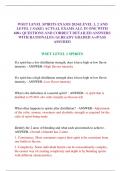
-
WSET LEVEL SPIRITS EXAMS 2024(LEVEL 1, 2 AND LEVEL 1 SAKE) ACTUAL EXAMS ALL IN ONE WITH 600+ QUESTIONS AND CORRECT DETAILED ANSWERS WITH RATIONALES /ALREADY GRADED A+/PASS ASSURED
- Exam (elaborations) • 103 pages • 2024
-
- $25.49
- + learn more
WSET LEVEL SPIRITS EXAMS 2024(LEVEL 1, 2 AND LEVEL 1 SAKE) ACTUAL EXAMS ALL IN ONE WITH 600+ QUESTIONS AND CORRECT DETAILED ANSWERS WITH RATIONALES /ALREADY GRADED A+/PASS ASSURED
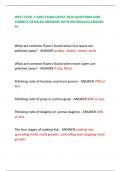
-
WSET LEVEL 1 SAKE EXAM LATEST 2024 QUESTIONS AND CORRECT DETAILED ANSWERS WITH RATIONALES|GRADED A
- Exam (elaborations) • 37 pages • 2024
- Available in package deal
-
- $7.99
- + learn more
What are common flavors found when less layers are polished away? - ANSWER-acidity, umami, cereal, lactic What are common flavors found when more layers are polished away? - ANSWER-fruity, floral Polishing ratio of honjozo and most junmai - ANSWER-70% or less
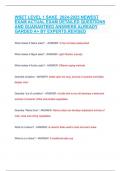
-
WSET LEVEL 1 SAKE 2024-2025 NEWEST EXAM ACTUAL EXAM DETAILED QUESTIONS AND GUARANTEED ANSWERS ALREADY GARDED A+ BY EXPERTS.REVISED
- Exam (elaborations) • 34 pages • 2024
-
- $23.99
- + learn more
WSET LEVEL 1 SAKE NEWEST EXAM ACTUAL EXAM DETAILED QUESTIONS AND GUARANTEED ANSWERS ALREADY GARDED A+ BY EXPERTS.REVISED What makes it Nama sake?` - ANSWER- It has not been pasteurized What makes it Nigori sake? - ANSWER- Light filtration (cloudy) What makes it Koshu sake? - ANSWER- Different aging methods Describe oxidation - ANSWER- bottle open too long, aromas of caramel and toffee, deeper color Describe "out of condition" - ANSWER- a bottle that is too old develops unwelcome ...
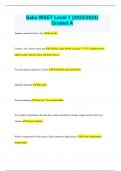
-
Sake WSET Level 1 (2023/2024) Graded A
- Exam (elaborations) • 8 pages • 2023
- Available in package deal
-
- $9.99
- 1x sold
- + learn more
Sake WSET Level 1 (2023/2024) Graded A Japanese name for basic sake Futsu-shu Color(s), abv, flavors futsu-shu Colorless, pale yellow or green. 15-17%. Slightly sweet, lightly acidic, delicate lactic and fruity flavors Two big aroma categories of Sake Floral/fruity and cereal/lactic Daiginjō meaning 'Big' ginjō Junmai meaning 'Pure rice'; No alcohol added Two grades of premium sake that have more cereal/lactic aromas, higher acidity and more umami. Junmai, honjōzō What is responsib...
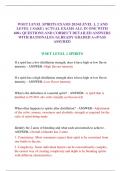
-
WSET LEVEL SPIRITS EXAMS 2024(LEVEL 1, 2 AND LEVEL 1 SAKE) ACTUAL EXAMS ALL IN ONE WITH 600+ QUESTIONS AND CORRECT DETAILED ANSWERS WITH RATIONALES /ALREADY GRADED A+/PASS ASSURED
- Exam (elaborations) • 103 pages • 2024
-
- $17.99
- + learn more
WSET LEVEL SPIRITS EXAMS 2024(LEVEL 1, 2 AND LEVEL 1 SAKE) ACTUAL EXAMS ALL IN ONE WITH 600+ QUESTIONS AND CORRECT DETAILED ANSWERS WITH RATIONALES /ALREADY GRADED A+/PASS ASSURED WSET LEVEL 1 SPIRITS If a spirit has a low distillation strength, does it have high or low flavor intensity - ANSWER--High flavour intensity If a spirit has a high distillation strength does it have high or low flavor intensity - ANSWER--Low flavor intensity
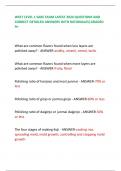
-
WSET LEVEL 1 SAKE EXAM LATEST 2024 QUESTIONS AND CORRECT DETAILED ANSWERS WITH RATIONALES|GRADED
- Exam (elaborations) • 37 pages • 2024
- Available in package deal
-
- $16.49
- + learn more
What are common flavors found when less layers are polished away? - ANSWER-acidity, umami, cereal, lactic What are common flavors found when more layers are polished away? - ANSWER-fruity, floral Polishing ratio of honjozo and most junmai - ANSWER-70% or less Polishing ratio of ginjo or junmai ginjo - ANSWER-60% or less Polishing ratio of daiginjo or junmai daiginjo - ANSWER-50% or less The four stages of making Koji - ANSWER-cooling rice, spreading mold, mold growth, controlling ...

-
WSET LEVEL 1 SAKE EXAM LATEST 2024 QUESTIONS AND CORRECT DETAILED ANSWERS WITH RATIONALES|GRADED A+
- Exam (elaborations) • 37 pages • 2024
-
- $9.49
- + learn more
What are common flavors found when less layers are polished away? - ANSWER-acidity, umami, cereal, lactic What are common flavors found when more layers are polished away? - ANSWER-fruity, floral Polishing ratio of honjozo and most junmai - ANSWER-70% or less Polishing ratio of ginjo or junmai ginjo - ANSWER-60% or less Polishing ratio of daiginjo or junmai daiginjo - ANSWER-50% or less The four stages of making Koji - ANSWER-cooling rice, spreading mold, mold growth, co...
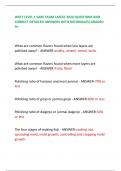
-
WSET LEVEL 1 SAKE EXAM LATEST 2024 QUESTIONS AND CORRECT DETAILED ANSWERS WITH RATIONALES|GRADED
- Exam (elaborations) • 37 pages • 2024
-
- $13.49
- + learn more
What are common flavors found when less layers are polished away? - ANSWER-acidity, umami, cereal, lactic What are common flavors found when more layers are polished away? - ANSWER-fruity, floral Polishing ratio of honjozo and most junmai - ANSWER-70% or less Polishing ratio of ginjo or junmai ginjo - ANSWER-60% or less Polishing rat

-
WSET LEVEL SPIRITS EXAMS 2024(LEVEL 1, 2 AND LEVEL 1 SAKE) ACTUAL EXAMS ALL IN ONE WITH 600+ QUESTIONS AND CORRECT DETAILED ANSWERS WITH RATIONALES /ALREADY GRADED A+/PASS ASSURED
- Exam (elaborations) • 103 pages • 2024
-
- $25.49
- + learn more
WSET LEVEL SPIRITS EXAMS 2024(LEVEL 1, 2 AND LEVEL 1 SAKE) ACTUAL EXAMS ALL IN ONE WITH 600+ QUESTIONS AND CORRECT DETAILED ANSWERS WITH RATIONALES /ALREADY GRADED A+/PASS ASSURED
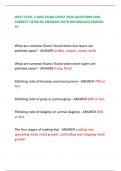
-
WSET LEVEL 1 SAKE EXAM LATEST 2024 QUESTIONS AND CORRECT DETAILED ANSWERS WITH RATIONALES|GRADED A+ What are common flavors found when less layers are polished away? - ANSWER-acidity, umami, cereal, lactic What are common flavors found when more layers ar
- Exam (elaborations) • 37 pages • 2024
-
- $17.99
- + learn more
WSET LEVEL 1 SAKE EXAM LATEST 2024 QUESTIONS AND CORRECT DETAILED ANSWERS WITH RATIONALES|GRADED A+ What are common flavors found when less layers are polished away? - ANSWER-acidity, umami, cereal, lactic What are common flavors found when more layers are polished away? - ANSWER-fruity, floral Polishing ratio of honjozo and most junmai - ANSWER-70% or less Polishing ratio of ginjo or junmai ginjo - ANSWER-60% or less Polishing ratio of daiginjo or junmai daiginjo - ANSWER-50% or less...

How did he do that? By selling his study resources on Stuvia. Try it yourself! Discover all about earning on Stuvia


